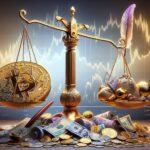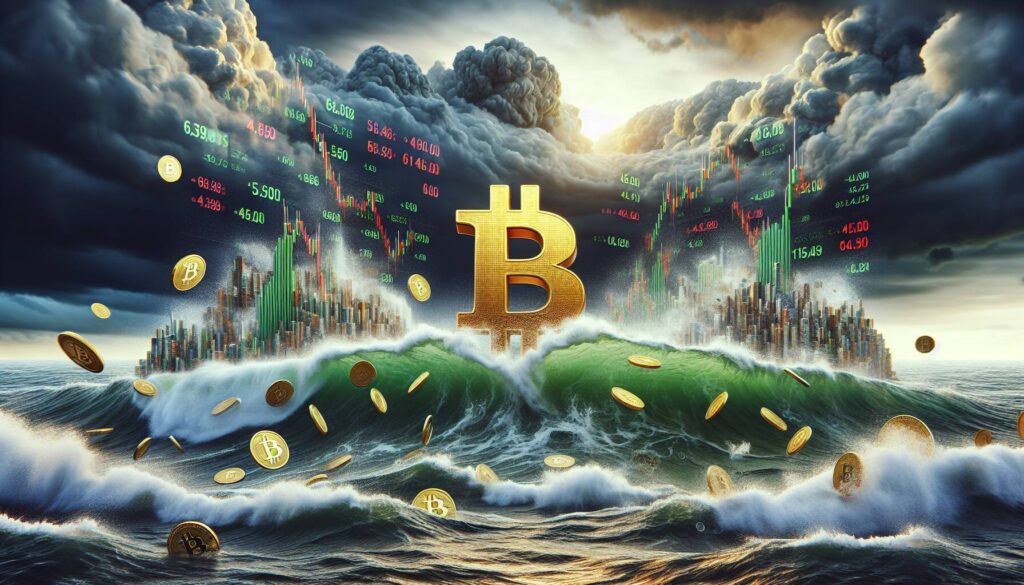The ongoing trend of the “debasement trade,” characterized by a growing preference for hard assets such as Bitcoin and gold, is making waves in the financial world. With Bitcoin priced over $120,000 and approaching its all-time high of $124,000, and gold nearing $3,900 and showing a remarkable year-to-date increase of nearly 50%, the enthusiasm surrounding these assets is palpable. Recent data highlights the surge in trading activity, particularly in exchange-traded funds (ETFs) that focus on these commodities.
“Everyone wants in on the debaser trade I guess,”
stated Bloomberg Senior ETF analyst Eric Balchunas. On a notable trading day, both BlackRock’s iShares Trust (IBIT) and the SPDR Gold ETF (GLD) secured their spots among the top ten most traded ETFs, an achievement that reflects the heightened market interest. The GLD experienced an impressive $4.88 billion in trading volume, positioning it as the fourth most traded ETF, while the IBIT followed closely with $3.21 billion in volume.
Adding to this narrative, comedian and sound money advocate Dominic Frisby pointed out that both Bitcoin and gold are distinctive in their rarity; unlike fiat currencies, they are not subject to government printing, which adds to their allure during uncertain economic periods. Frisby remarked, “Bitcoin’s within a couple of percent of all-time highs. Gold’s at all-time highs. Silver’s closing in on all-time highs.” This sentiment underscores a broader skepticism towards fiat currency, as investors increasingly turn to assets that are perceived as being immune to devaluation.
As silver also thrives, currently trading just below $48, it suggests a historical pattern where its peaks align with gold’s. Observers note that if silver’s surge concludes, it could signal a similar fate for gold, potentially paving the way for Bitcoin to capitalize on this momentum. With all these developments, the debasement trade seems positioned for a significant chapter as investors seek refuge in these hard assets.

The Debasement Trade: A New Era for Hard Assets
The following points highlight the significant trends and insights related to the debasement trade and its potential impact on financial markets:
- Bitcoin’s Resurgence:
- Bitcoin (BTC) is trading above $120,000, close to its all-time high of $124,000.
- Signals strong investor interest in digital currencies as a hedge against inflation.
- Gold’s Record Performance:
- Gold has increased nearly 50% year-to-date, reaching new highs below $3,900.
- Gold’s stability during economic uncertainty reinforces its role as a safe haven asset.
- High ETF Trading Volume:
- The iShares Trust (IBIT) and SPDR Gold ETF (GLD) ranked among the top traded ETFs, indicating strong market interest.
- GLD saw $4.88 billion in volume, the fourth most traded ETF, showcasing the movement towards hard assets.
- Investor Sentiment Shift:
- The phenomenon hints at a growing distrust in fiat currencies and government-manipulated money supply.
- Historically, assets like bitcoin and gold have thrived during such shifts, suggesting a long-term trend.
- Silver’s Position:
- Silver is trading just below $48, nearing its historical peaks, paralleling gold’s rise.
- Historical patterns suggest a potential correlation between the peaks of silver and gold, which could impact future investments.
- Implications for Investors:
- Investors may benefit from diversifying their portfolios with assets that are resistant to debasement.
- Awareness of these trends can help shape investment strategies moving forward.
Analyzing the Emergence of the Debasement Trade: Bitcoin and Gold Insights
The debasement trade is gaining remarkable traction, with Bitcoin and gold leading the charge. Bitcoin, having recently surpassed $120,000, is tantalizingly close to its peak, while gold’s year-to-date surge has seen it nearly reach $3,900. The simultaneous ascent of these hard assets reflects a growing skepticism towards fiat currencies, attracting diverse investor interest.
Competitive Advantages: A significant advantage for Bitcoin and gold lies in their shared quality of being non-fiat commodities. Unlike currencies that are subject to inflationary pressures from government printing, both assets provide a hedge against economic uncertainty. The impressive trading volumes of the BlackRock iShares Trust and SPDR Gold ETF underscore this growing enthusiasm; they join the ranks of the most actively traded ETFs, capturing the attention of institutional and retail investors alike.
Disadvantages: However, the landscape isn’t devoid of challenges. High volatility remains a notable concern for Bitcoin, which may limit its appeal to risk-averse investors. Furthermore, skyrocketing prices for gold and silver could deter new investors who may feel that the opportunities have already passed them by. This could result in a market correction in the short term, prompting worries about overextension in pricing.
These developments favor a specific segment of investors: those who prioritize safeguarding their wealth against currency debasement. Wealthy individuals and institutional investors are likely to benefit the most, as they can navigate the complexities of these investments more smoothly. Conversely, retail investors or those unaccustomed to market fluctuations may find themselves at a higher risk of losses if prices correct rapidly.
Moreover, the historical correlation between gold and silver suggests that as one rallies, the other often follows. If past trends continue, a peak in silver could lead to a price stabilization or decline in gold, impacting investor sentiment in the debasement trade overall. Investors need to remain vigilant, as the interplay of these assets can create both opportunities and pitfalls in a rapidly evolving market landscape.
















